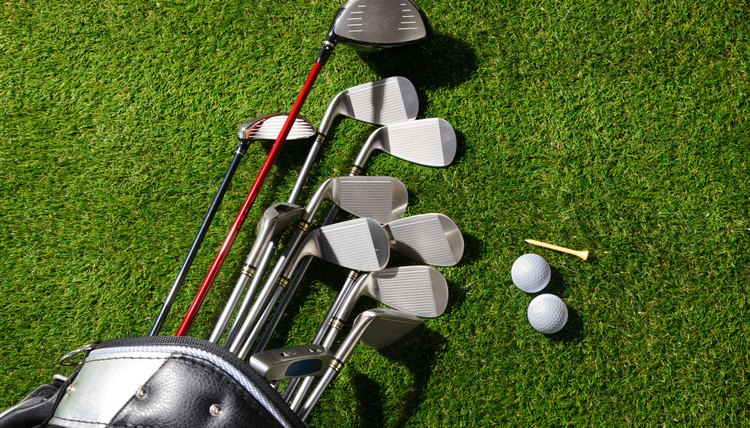How to Use a 7 Iron

Golfers select which of their iron clubs to use based on the distance to the hole and the terrain of their hitting area. The 7-iron golf club is one of the middle irons and is best suited for shots in the 140- to 170-yard range -- although handicap golfers can hit much longer shots with this club and beginners may struggle to reach this range with their golf swing. The 7-iron features a shorter shaft and more clubhead loft than the longer irons, typically 34 to 36 degrees depending on the manufacturer. This creates a greater striking surface on the clubhead, making 7-iron shots easier to control than the longer irons.
When to use the 7-iron?
This club is appropriate for "laying up" near the green for solid chipping position, putting the golf ball in a good fairway spot with the second shot on a par-4 hole or the third shot on a long par-5 hole. The 7-iron also can be used instead of the 8- or 9-iron for longer "bump-and-run" shots on hard, dry courses with few hazards.
How to address the Ball?
When you set up for the 7-iron shot, your hands should be ahead of the ball with the shaft leaning forward upon address. The ball position should be further back in your stance than it would be with a driver or long iron, since you are striking the ball right before your swing reaches its lowest point -- and not just beyond the lowest point, as you would with the driver.
Accuracy Over Distance
The 7-iron has 3 to 4 degrees more loft on the club face than the 6-iron and 6 to 8 degrees more loft than the 5-iron. This added loft creates a greater hitting surface but subtracts distance. For the average golfer, the average 7-iron distance is 10 to 20 fewer average distance yards than the 6-iron and 20 to 40 fewer average distance yards than the 5-iron. This sacrifice in power means an easier time at creating good approach shots on the golf course. This is why many PGA tour players will utilize this club on the fairway instead of trying to blast a hybrid or fairway wood throughout their golf game.
How to swing a 7-iron?
Since this club is often used for placement instead of great distance, many 7-iron shots call for a shorter backswing, three-quarters swing velocity and an abbreviated follow-through. Less experienced golfers trying to measure these shots tend to scoop their 7-iron shots by hitting under the ball, as they would with a lob wedge or pitching wedge. Instead, you should strike the ball as you would with the other mid-irons -- with a slight descending blow near the bottom of your downswing. This striking angle adds backspin and natural lift to your shot. Here is a full video from Expert Village demonstrating how to do the full swing and get consistently good golf shots. Be sure to practice at a driving range so you can grasp the many key takeaways and golf tips.
Rhythm Over Power
While many beginner golfer may worry about swing speed and power, the key to good ball flight is rhythm. In a story for Golf Digest, former PGA golfer Nick Faldo recalled a valuable 7-iron practice routine he received from an early teacher. "He had me hit six 7-iron shots as hard as I could. He then had me hit six 7-iron shots so easily they flew only 100 yards," Faldo said. "He then asked me to increase the distance in 10-yard increments, six swings for each. Before I knew it, I was hitting the 7-iron the original maximum-swing distance, but with hardly any effort. It proved that good rhythm, not sheer power, is what makes the ball go long -- and straight."
Writer Bio
Jeff Gordon has been reporting and writing since 1977. His most recent work has appeared on websites such as eHow, GolfLink, Ask Men, Open Sports, Fox Sports and MSN. He has previously written for publications such as "The Sporting News" and "The Hockey News." He graduated from the University of Missouri-Columbia School of Journalism in 1979 with a bachelor's degree.
